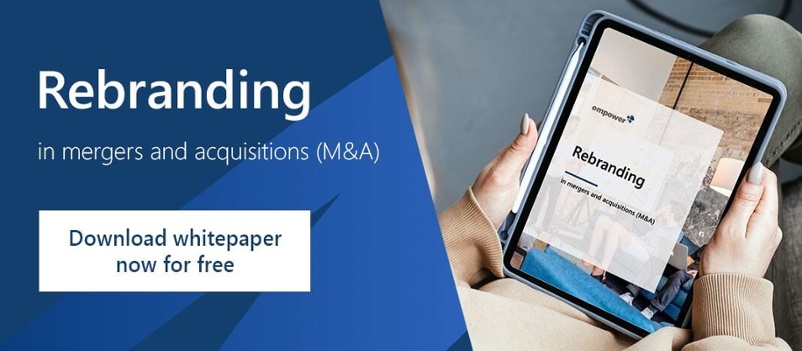Against the background of M&A, a company often must reorient and reposition itself. Often they chose to start the rebranding process, which we adressed extensively in our rebranding guide. In many cases, faulty brand integration leads to failure of the merger; brand awareness and trust suffer; projects fall short of expectations, or even fail altogether. One of our examples even shows that poor brand management resulted in sales losses of 17 %.
Many M&A guidebooks do not go far enough into detail about rebranding after a corporate merger or acquisition. In our whitepaper we analyze M&A-related rebranding tasks, look at KPIs and reasons for M&A failures, and highlight rebranding’s role after a merger or acquisition. We then show you how to proceed to successfully implement a rebrand, and software tools that support you in doing so.
M&A as a reason for rebranding
2021 was a new record year in mergers & acquisitions. Rebranding is an inevitable part of M&A for many companies. According to a study by Landor, as many as three out of four acquisitions lead to a subsequent rebranding. M&A ranks number one among the reasons for rebranding. Landor found that “small” deals most often lead to rebranding. Acquisitions under the 100 million mark leads to a rebrand about 78 percent of the time. Viewed individually, various factors play a role in the extent to which a rebranding makes sense and is promising.
Rebranding after a merger promotes profits through efficiency gains and cost reductions. It can increase brand growth through the acquisition of new products, markets, and customers, as well as elevating brand awareness and trust.
A strong brand promotes the profitability of the business. And deep brand understanding among customers creates long-term shareholder value.
Rebranding after a merger is not mandatory. Need for a rebranding depends on the company and brand situation. If rebranding is required, it will be an especially important factor for the success of the corporate merger and should therefore be well prepared and carried out.
Reasons to rebrand after M&A
- The buyer’s brand is stronger than the acquired brand / acquired brand should be rebranded
- The buyer’s brand is weaker than the acquired brand in an important market
- Organizational changes and integration
- Changes in the company’s product range
- Cost savings
- Regulatory and contractual requirements
Reasons not to rebrand after M&A
- Strong existing brand / impairment of customer loyalty
- Cultural differences in companies
- Complex accounting (rebranding may require amortization of purchased brand equity, reducing first-year accounting profit even though actual performance is unaffected)
- Planned disposals of the purchased company
- Too much time and effort for management
- Questionable benefits

Successful implementation of a rebranding after M&A
A well-prepared rebranding process reduces costs and increases efficiency. To create clarity for customers and employees, a structured and transparent process is crucial. Define your rebranding goals clearly from the start and have them in mind at every step of the way.
The following sections will help you plan, prepare, and execute your rebranding. We go into individual process steps such as analysis, definition of the brand character, and corporate design, as well as communication, internal briefing, and external rollout.
Successfully implementing the rebranding strategy in five steps
Step 1: Analysis
Before you get into the concrete planning of your rebranding, an in-depth analysis is first necessary. Focus on aligning your vision with that of your (potential) customers, and differentiating yourself from the competition. Analysis allows you to do a before-and-after comparison and identify further opportunities for adapting your brand.
Companies should first ask themselves the following questions using due diligence:
- Do we want to keep the brand alive?
- Do we want to merge the acquired brand with an existing brand, or do we want to eliminate the brand entirely?
Define your target group during the analysis.
- Which customers do you want to reach with your products?
- What are the wishes and needs of your target group?
Identify your direct and indirect competitors. Find out what works among them. Ask yourself what the current trends are in the market. ’But do not blindly chase the latest branding trends if ’they do not fit your company’s values and identity.
Step 2: Definition of the brand character
In this step, determine your brand’s corporate identity. Ask yourself the following questions:
- Where do you see your strengths and weaknesses?
- What makes you who you are today?
- What is your USP / core competence?
- What makes your company / brand / products different from others?
- What do you get up for every morning? What values determine your daily actions?
- What do you get up for every morning? What values determine your daily actions?
- How would you describe your company if it were a person?
Create a detailed overview of a company’s mission, values, and vision. ’Remain authentic! Answer uncomfortable questions honestly and ask yourself what you want to achieve with rebranding and what is realistic.
.png?width=900&name=m%26a-plan(1).png)
Step 3: Corporate design and communication
Rebranding almost always includes a change to corporate design and communication of the brand. Think about which areas will change. This could be the logo, the corporate colors and fonts, the website, brand icons, and other marketing materials. The more senses you integrate into communication, the greater its tangibility and memorability.
- How can the defined brand identity be transferred to the corporate identity?
- Which brand names should continue to be used?
- Does the design reflect business goals and ideas?
- Is it concise and clearly differentiated from the competition?
- Is it applicable to different media and easy to use?
- Is the brand image consistent across all channels?
Getting professional support in marketing communications can be a wise decision. Especially for companies without their own design or graphics department, agencies are often indispensable and provide support in the development and implementation of a new corporate design. But large companies and corporations can also benefit from the knowledge and tools of external partners. In every case, the agency or consultant must understand your vision.
Remember to inform your customers that there will be innovations.
Give them insights into your process and help them understand the background. Communication increases acceptance of the rebranding.
Step 4: Internal briefing
Rebranding is a crucial transformation of your brand, and employees need to continue to identify with it. If they feel cheated or betrayed in any way, it can jeopardize the entire merger. So be open, fair, and honest.
It is common for brand and marketing teams to be excluded from M&A discussions. That can be a costly mistake. Marketing teams are acutely aware of the brand value at stake, and this is often not appreciated or understood across departments. Successfully informing, engaging, and empowering employees before the external launch is critical.
4 basic pillars to integrate all employees in the merger process
- As soon as employees are enthusiastic about their own company and passionate about the philosophy behind it, they cannot be outweighed by any advertising campaign or award.
- Common values will support enthusiasm and compliance with the rebrand. To help all employees work together effectively after the acquisition, management must ensure a common understanding and convince them of the logic behind the merger or acquisition.
- Encourage your employees to use words like “our” and “we”: our customers, our employees, we covered, etc. This is critical to a strong company culture.
- Particularly in the case of international mergers, the aim is often to leave parallel cultures in place instead of imposing the mentality of one company on the other. Only about one-fifth of mergers and acquisitions worldwide involve complete cultural integration.
Step 5: External Rollout
As soon as your decision for a new corporate design has been made and implemented, rollout and public presentation follow. At the heart of the matter is the question:
- How do you succeed in making your brand essence tangible internally and externally at all points of contact and present it in a consistent manner?
The new design must be applied to all means of communication (business stationery, presentations, website, catalogs, social media ...). For a successful rebranding, understand that your brand image is a product of many factors and rarely remains unchanged. You should closely monitor and analyze the results of your rebranding process and adjust your decisions as necessary.
Examples of successful rebrandings after M&As
ExxonMobil

ExxonMobil took a conservative approach to the merger. This involved using the brand identity values of both companies and integrating them into the new corporate identity. The brand names were merged and Exxon and Mobil became ExxonMobil. This conveyed a blend of brand values, with certain elements of both merger partners retained.
ExxonMobil’s merger approach focused more on risk management than on activating new potential. That approach can prevent alienating teams and customers. This type of merger radiates a shared future for both companies.
The deal was completed for US$80 billion. Since then investors have quadrupled their money and shares have risen 293 % on reinvestment of dividends. Despite initial skepticism, the merger is now considered one of the most successful in history.
Verizon

Sometimes it makes most sense to create an entirely new brand. That was the approach taken by the US telephone companies GTE and Bell Atlantic when they merged to form Verizon. This approach is usually best suited for categories undergoing extreme change, where the merging companies want to signal their evolution.
The Verizon merger happened when telecommunications was moving strongly in the direction of mobile communications. The companies wanted to clarify their innovative future with a new name.
We collected further examples for rebranding in a different article.
Successful rebranding with empower®
empower® ensures that the new designs and guidelines you have defined as part of your rebranding are received by all employees and implemented in all Office applications. Existing PowerPoint presentations can be transferred to your new corporate design with just a few clicks. This also applies to Word documents, Excel charts, among other things, as well as to updating e-mail signatures and updating your templates.
empower® saves valuable working time because existing presentations do not have to be adapted manually but are automatically updated and converted into a new design.
The empower® solution for rebranding helps you to efficiently perform a rebranding after M&A. We have conducted an interview with K16, one of the leading communication agencies in Germany, to talk about what to consider in a new corporate when rebranding after M&A. If you have any questions on how we can support your rebranding please don't hesitate to contact us.
You May Also Like
Related articles

Rebranding strategy – what you should consider

Interview: New corporate design after M&A



